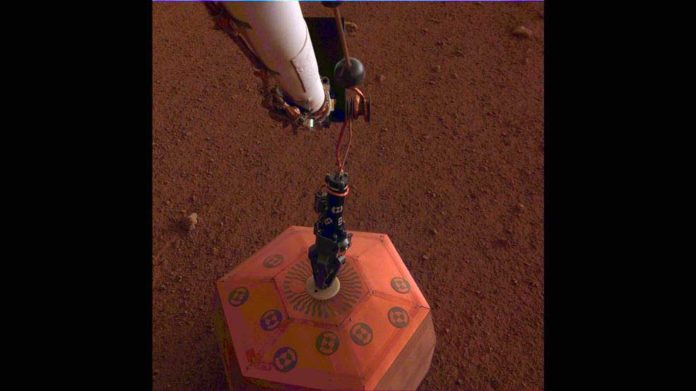NASA’s InSight lander has conveyed its first instrument onto the surface of Mars, finishing a noteworthy mission milestone. The lander has deployed the seismometer and the heat probe.
The images released by the InSight show the seismometer on the ground, it’s copper-colored covering faintly illuminated in the Martian dusk. It looks as if all is calm and all is bright for InSight, heading into the end of the year.
Before deploying, engineers tested the commands for the lander. They verified that the robotic arm that picks up and places InSight’s instruments onto the Martian surface was working properly. They then made sure a model in the testbed at JPL deployed the instruments exactly as intended. Scientists also had to analyze images of the Martian terrain around the lander to figure out the best places to deploy the instruments.
InSight Project Manager Tom Hoffman, who is based at NASA‘s Jet Propulsion Laboratory in Pasadena, California said, “InSight’s timetable of activities on Mars has gone better than we hoped. Getting the seismometer safely on the ground is an awesome Christmas present.”
The InSight team has been working carefully toward deploying its two dedicated science instruments onto Martian soil since landing on Mars on Nov. 26. Meanwhile, the Rotation and Interior Structure Experiment (RISE), which does not have its own separate instrument, has already begun using InSight’s radio connection with Earth to collect preliminary data on the planet’s core. Not enough time has elapsed for scientists to deduce what they want to know — scientists estimate they might have some results starting in about a year.
On Tuesday, Dec. 18, InSight engineers sent up the commands to the spacecraft. On Wednesday, Dec. 19, the seismometer was gently placed onto the ground directly in front of the lander, about as far away as the arm can reach — 5.367 feet, or 1.636 meters, away).
InSight Principal Investigator Bruce Banerdt, also based at JPL said, “Seismometer deployment is as important as landing InSight on Mars. The seismometer is the highest-priority instrument on InSight: We need it in order to complete about three-quarters of our science objectives.”
The seismometer allows scientists to peer into the Martian interior by studying ground motion — also known as marsquakes. Each marsquake acts as a kind of flashbulb that illuminates the structure of the planet’s interior. By analyzing how seismic waves pass through the layers of the planet, scientists can deduce the depth and composition of these layers.
Philippe Lognonné, principal investigator of SEIS from Institut de Physique du Globe de Paris (IPGP) and Paris Diderot University said, “Having the seismometer on the ground is like holding a phone up to your ear. We’re thrilled that we’re now in the best position to listen to all the seismic waves from below Mars’ surface and from its deep interior.”
